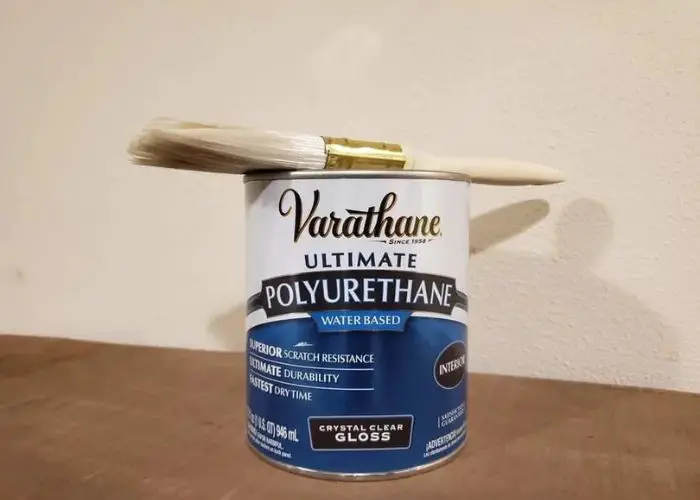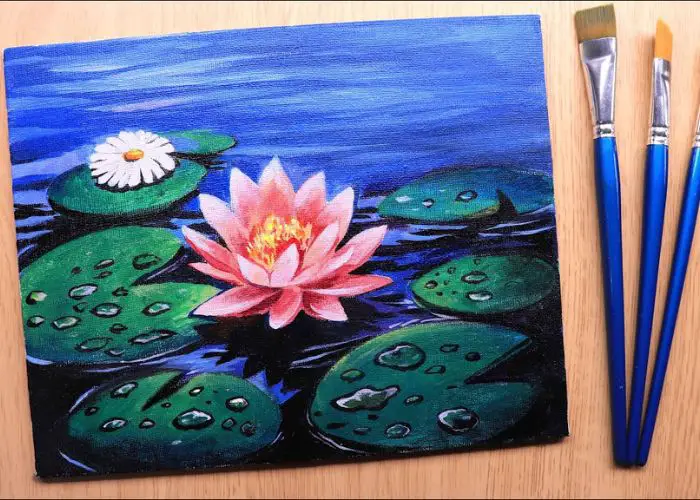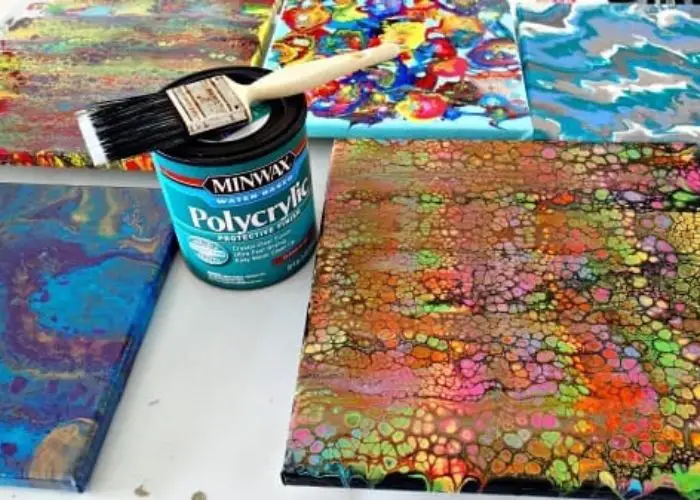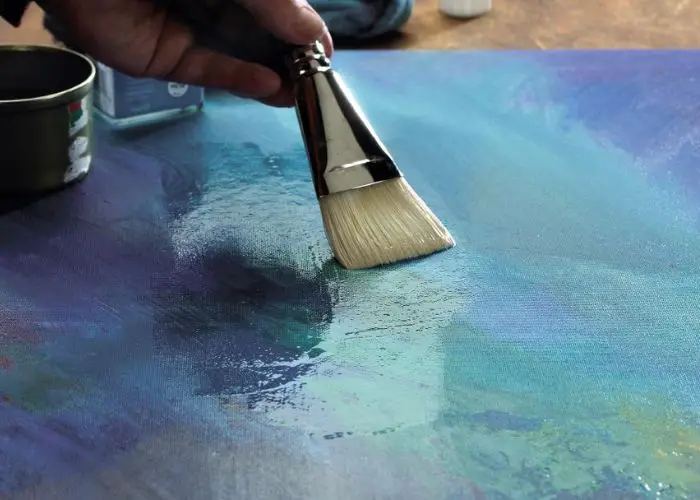You can put polyurethane over acrylic paint, but you should take a few things into consideration before doing so.
This article will discuss what polyurethane is, whether or not you can use it over acrylic paint, and the best way to do so.
We will also cover how long the paint needs to dry before using polyurethane and what you need to consider before applying it.
Finally, we will give you tips on how to seal acrylic paint with polyurethane.
Can You Put Polyurethane Over Acrylic Paint?
Yes, you can put both oil-based and water-based polyurethane over acrylic paint. However, oil-based polyurethanes can yellow the paint over time, so use a clear coat if you are using an oil-based poly. Water-based poly will not yellow the paint and can be used without a clear coat. However, they can cause the paint to dull slightly.
What is Polyurethane?

If you’ve ever shopped for furniture, you’ve probably come across the term “polyurethane.” But what is polyurethane, and why is it so important?
Polyurethane is a type of plastic created by combining two chemicals, polyisocyanate, and polyol.
Together, these two substances create a strong, durable material that can be used in a variety of applications.
One of the most popular uses for polyurethane is in furniture. It is often used as a coating for wood furnishings, as it provides a protective barrier against spills and stains.
Additionally, polyurethane is also used in the construction of many types of insulation.
This material is especially effective at preventing heat loss, making it ideal for use in homes and businesses.
Can You Use Polyurethane Over Acrylic Paint?
Now that we know what polyurethane is, let’s answer the question: can you put polyurethane over acrylic paint? But first, can you paint over an acrylic painting? Find out.
The short answer is yes, but there are a few things you need to take into account before doing so.
One of the most important things to consider is the type of paint you are using. Acrylic paint is water-based, while polyurethane is both water-based and oil-based.
As a result, it is not recommended to put polyurethane over oil-based paint. However, you can put polyurethane over acrylic paint as long as you take the proper precautions.
Will Polyurethane Ruin Acrylic Paint?
Another important consideration is whether or not polyurethane will ruin your paint job.
While polyurethane can sometimes cause yellowing or fading, this is typically only a problem with oil-based paint.
When you apply polyurethane over paint, especially acrylics, the polyurethane will not cause any damage.
In fact, it can actually help to protect your paint job from wear and tear.
What is the Best Polyurethane for Acrylic Paint?
Now that we know you can put polyurethane over acrylic paint, you might be wondering what the best type of polyurethane to use is.
When it comes to choosing polyurethane, there are two main types: water-based and oil-based. Water-based polyurethane is typically the best choice for use over acrylic paint.
This type of polyurethane goes on clear and dries quickly, making it ideal for those who want to protect their paint job without changing its appearance.
Oil-based polyurethane can also be used, but it may produce a yellow or amber hue to your paint color.
How Long for Paint to Dry Before Using Polyurethane?
Once you’ve decided on the type of polyurethane you want to use; the next step is to make sure your paint is completely dry before applying it.
Depending on the type of paint you are using, this can take anywhere from 24 to 48 hours.
Once your paint is dry, you can begin applying the polyurethane. If using acrylic paint, you should wait at least 1 day before applying polyurethane.
This will give the paint plenty of time to cure, ensuring that the polyurethane adheres properly.
What to Consider Before Using Polyurethane on Top of Acrylic Paint?

Now that you know how to put polyurethane over acrylic paint, it’s time to consider a few things before doing so.
One of the most important things to keep in mind is that polyurethane is a protective coating. As such, it can make your paint job more susceptible to chips and scratches.
Therefore, if you plan to use polyurethane in an area that is likely to see a lot of wear and tear, you might want to consider a different option.
Additionally, polyurethane can sometimes cause yellowing or fading. If you are concerned about this, you can try using a clear coat of polyurethane.
This will help to protect your paint job while still allowing the color to show through.
Should I Seal My Acrylic Painting?
It depends, acrylic paint is also susceptible to damage from UV light and heat.
So, if you’re planning to hang your painting in a sunny spot, or if it will be in a place where it might be exposed to high temperatures, then sealing it with a varnish or UV-resistant coating is a good idea.
On the other hand, if your painting will be kept indoors in a cool, dark place, then sealing it isn’t necessary.
How to Seal Acrylic Paint with Polyurethane
Once you’ve considered all of the above factors, it’s time to learn how to apply polyurethane over acrylic paint.
- The first step is to sand your paint job. This will help to create a smooth surface for the polyurethane to adhere to.
- Once you’ve sanded your paint job, you can then begin applying the polyurethane.
- When applying polyurethane, it’s important to use even strokes and to avoid over-applying.
- Once you’ve applied the polyurethane, you can then allow it to dry.
- Depending on the type of polyurethane you are using, this can take anywhere from 24 to 48 hours.
Minwax Polycrylic Over Acrylic Paint
Now that we’ve answered the question, “can you put polyurethane over acrylic paint,” let’s take a look at another common question: can you use Minwax polycrylic protective finish over acrylic paint?
The answer is yes! Minwax polycrylic is a clear, water-based finish that can be used over both oil- and water-based paints.
It can be applied with a brush, roller, or sprayer and dries quickly to a clear, durable finish.
Polycrylic is available in both gloss and satin finishes, so you can choose the one that best suits your needs.
Read: Satin finish vs matte
Can You Clear Coat Acrylic Paint
Yes, you can clear coat acrylic paint. Clear coating is a process in which a clear finish is applied over the top of a painted surface.
This can be done for both protection and aesthetic purposes. Clear coats can help to protect your paint job from scratches, fading, and wear and tear.
They can also give your paint job a glossy finish, making it look like new. Clear coats such as acrylic resin varnish can be applied with a brush, roller, or sprayer.
If you are using a clear coat for protection, choose one that is compatible with the type of paint you are using.
For example, if you use acrylic paint, you will want to choose the best clear coat for acrylic paint rather than just any paint.
Can You Use Helmsman Spar Urethane Over Acrylic Paint?
Yes, you can use Helmsman Spar Urethane over acrylic paint.
Helmsman Spar Urethane is a clear, water-based polyurethane that can be used on both oil- and water-based paints including flat satin and gloss finishes.
It can be applied with a foam brush, roller, or sprayer and dries quickly to a clear, durable finish.
Spar Urethane is available in both gloss and satin finishes, so you can choose the one that best suits your needs.
When applying Spar Urethane, make sure to use even strokes and to avoid over-applying.
Once you’ve applied the Spar Urethane, you can then allow it to dry. Depending on the type of Spar Urethane you are using, this can take anywhere from 24 to 48 hours.
Can You Put Lacquer Over Acrylic Paint?
You can put lacquer over acrylic paint, but you need to be sure that the paint is dry first.
If the paint is still wet, the lacquer will not adhere properly and can cause the paint to chip or peel.
You also need to be careful about the type of lacquer you use. Some lacquers can be quite harsh and may damage the paint underneath.
If you’re not sure which lacquer to use, it’s best to ask a professional for advice.
Can You Put Oil-based Polyurethane Over Acrylic Paint?
Yes, you can put oil-based polyurethane over acrylic paint. Oil-based polyurethane is a clear finish that can be applied with a brush, roller, or sprayer.
It dries quickly to a clear, durable finish. When applying oil-based polyurethane, make sure to use even strokes and to avoid over-applying.
Once you’ve applied the polyurethane, you can then allow it to dry. Depending on the type of oil-based polyurethane you are using, this can take anywhere from 24 to 48 hours.
Related Post: Can You Mix Acrylic And Oil Based Paint?
Best Clear Coat Over Acrylic Paint

There are a few different types of clear coats that can be used over acrylic paint. These include oil-based polyurethane, water-based polyurethane, and lacquer.
Each type has its own advantages and disadvantages, so it’s important to choose the one that best suits your needs.
Oil-based polyurethane is a clear finish that can be applied with a brush, roller, or sprayer. It dries quickly to a clear, durable finish.
Water-based polyurethane is also a clear finish that can be applied with a brush, roller, or sprayer. It dries quickly but can sometimes leave a cloudy finish.
Finally, lacquer is a clear finish that can be applied with a brush or sprayer. It dries quickly but can be quite harsh and may damage the paint underneath.
Clear Coat for Water-based Acrylic Paint
While you can apply a clear coat over both oil- and water-based acrylics, you’ll get the best results if you use a clear coat that’s specifically designed for water-based paints.
Applying a clear coat will help to protect your paint job from scratches, UV rays, and other environmental damage. It will also make your paint job more durable and easier to clean.
If you’re planning to use your paint job in a high-traffic area or simply want it to last for many years to come, applying a clear coat is definitely worth the extra effort.
Can You Use Clear Coat Over Acrylic Craft Paint?
The short answer is yes! You can use a clear coat over an acrylic craft paint project to protect it. Plus, is craft smart paint non toxic? Craft Smart paints are non-toxic and water-based, which is safe for most households.
However, there are a few things to keep in mind when doing so. First, make sure that the clear coat is compatible with the paint you used.
Second, apply the clear coat in thin, even coats to avoid runs or drips. Finally, let the clear coat dry completely before using or handling your acrylic paint project.
FAQs
Can you put polyurethane over paint?
Yes, you can put polyurethane over paint. However, make sure that the paint is dry first. If the paint is still wet, the polyurethane will not adhere properly and can cause the paint to chip or peel. You also need to be careful about the type of polyurethane you use.
What can I seal over acrylic paint with?
A few different types of sealants can be used over acrylic paint, including oil-based polyurethane, water-based polyurethane, and lacquer. Each type has its own advantages and disadvantages, so it’s important to choose the one that best suits your needs.
Does polyurethane react with acrylic?
No, polyurethane does not react with acrylic. However, some types of polyurethane can be quite harsh and may damage the paint underneath. If you’re unsure which type of polyurethane to use, it’s best to ask a professional for advice.
Can you seal acrylic paint on wood with polyurethane?
Yes, you can seal acrylic paint on wood with polyurethane. Apply a water-based polyurethane sealer using a brush or roller, following the manufacturer’s instructions. Allow the acrylic wood sealer to dry completely between coats. Polyurethane provides a protective layer that helps prevent the acrylic paint from chipping, fading, or peeling on the wood surface.
Can you use polyurethane over acrylic latex paint?
Yes, you can use polyurethane over acrylic latex paint. However, you should only do this if the paint is in good condition. If the paint is peeling or flaking, remove it before applying the polyurethane.
Will polyurethane make acrylic paint glossy?
No, polyurethane will not make acrylic paint glossy. However, it will protect the paint from scratches and UV rays. It will also make the paint more durable and easier to clean.
How do I remove polyurethane from acrylic paint?
There are a few different ways to remove polyurethane from acrylic paint. You can use a chemical stripper, sandpaper, or a heat gun. If you’re unsure which method to use, it’s best to ask a professional for advice.
Can you paint acrylic enamel over urethane primer?
yes, you can. First, urethane primer is typically used for exterior surfaces, so be sure that the surface you’re painting is well-ventilated. Secondly, because urethane primer can be quite thick, you’ll need to thin it out before painting over it with acrylic enamel. Lastly, be sure to let the urethane primer fully dry before painting over it; otherwise, the paint can chip or flake off.
Conclusion
So, can you put polyurethane over acrylic paint? Yes! You can use a clear coat over an acrylic craft paint project to protect it.
However, there are a few things to keep in mind when doing so. First, make sure that the clear coat is compatible with the paint you used.
Second, apply the clear coat in thin, even coats to avoid runs or drips. Finally, let the clear coat dry completely before using or handling your project.











Leave a Reply